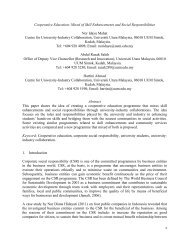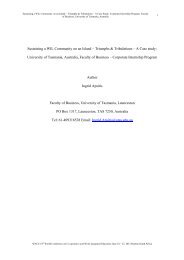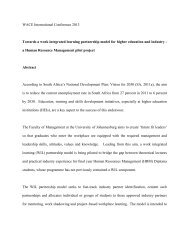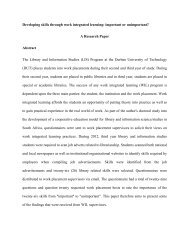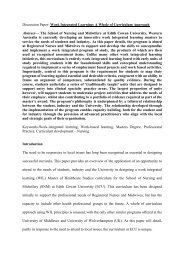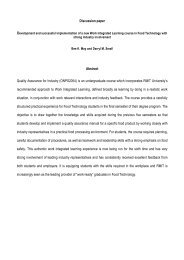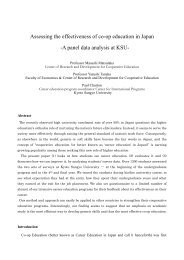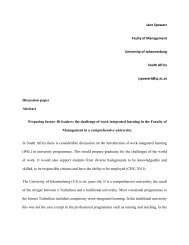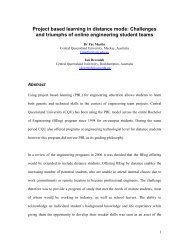Ratna Lindawati Lubis, Institut Manajemen Telkom ... - WACE
Ratna Lindawati Lubis, Institut Manajemen Telkom ... - WACE
Ratna Lindawati Lubis, Institut Manajemen Telkom ... - WACE
Create successful ePaper yourself
Turn your PDF publications into a flip-book with our unique Google optimized e-Paper software.
WORK-INTEGRATED EDUCATION:<br />
HOW STUDENTS’ ENTREPRENEURIAL TEAM<br />
CAN CAPITALIZE ON CONFLICT<br />
Category: Refereed Paper / Research Paper<br />
Abstract:<br />
This paper builds on previous study undertaken by the author, a discussion paper presented at the<br />
following events: (1) The 5 th Asia-Pacific Cooperative Education Conference 2004, Auckland,<br />
New Zealand; (2) The World Association for Cooperative Education (<strong>WACE</strong>) Asia-Pacific<br />
Conference 2006, Shanghai, China; (3) International Conference on Work Integrated Learning<br />
2010, Hong Kong SAR, China; (4) 17 th World Conference on Cooperative & Work-Integrated<br />
Education 2011, Philadelphia, USA.<br />
The present work is a continued action-research effort by the author to support the claims relating<br />
to the students’ benefit from work-integrated education, through the formation of entrepreneurial<br />
team.<br />
As organizations now rely heavily on teams and teamwork to conduct much of their business; the<br />
purpose of this paper is to examine the students’ perceptions on how students realize the potential<br />
inherent in conflict and capitalize on it. Thirty-six students’ entrepreneurial team from<br />
entrepreneurship course participated in this study during academic year of 2011/12, using a selfcompletion<br />
questionnaire.<br />
The findings, by and large, indicate that the burgeoning diversity of team members, which<br />
increases the likelihood of divergent perspectives, is simultaneously strength and a challenge. This<br />
paper is also aimed to illustrate on how the students’ entrepreneurial team turn conflict into an<br />
effective work-integrated education process. The paper continues with propositions that can lead<br />
to further research in this relatively unexplored field.<br />
Keywords:<br />
action-research, work-integrated education, entrepreneurial team, conflict<br />
Page 1 of 14
INTRODUCTION<br />
A definition of Work-integrated Education (WIE) appears on at least three webpages of The Hong<br />
Kong Polytechnic University (PolyU), namely the Faculty of Business, the <strong>Institut</strong>e of Textiles<br />
and Clothing, and Hong Kong Community College: “work-based learning experiences which take<br />
place in an organizational context relevant to a student’s future profession, or the development of<br />
generic skills that will be valuable in that profession”. Apparently the current choice of education<br />
(WIE) in the World Association for Cooperative Education (<strong>WACE</strong>) byline, which is a deviation<br />
from the former notion learning (WIL), is because education is considered the more complete,<br />
fuller term (learning and teaching combined). <strong>WACE</strong> is apparently also shifting away from using<br />
the original term cooperative education (Groenewald, 2012).<br />
While perceptions of ideal cooperative education differ across cultures and settings, this term is<br />
generally viewed as a learning situation where a group of students set up a common goal and solve<br />
problems through discussion within the group. Cooperative education is seen as an important<br />
mechanism for dealing with the complex and rapidly changing learning environment. For the<br />
purpose of this paper, the author defined WIE as a learning situation where a group of students set<br />
up a common goal and solve the problems through entrepreneurial team (ET).<br />
With an aim to explore the potential of teamwork experiences, starting from academic year 2003/4<br />
the author conducted the delivery of Entrepreneurship subject to undergraduate programs at<br />
<strong>Institut</strong> <strong>Manajemen</strong> <strong>Telkom</strong> (IM TELKOM), Bandung, West Java, Indonesia. All students have to<br />
take the Entrepreneurship subject – a-three credit points, consists of 14 weeks class sessions – that<br />
has included a compulsory entrepreneurial project to be eligible for graduation. This<br />
entrepreneurial team-based project gives students the opportunity to relate theory to practice and to<br />
be well prepared in the workplace. Furthermore, IM TELKOM strives to develop its students and<br />
equip them with its core values, stated as Integrity, Entrepreneurship and Best for Excellence.<br />
There are few studies to date concerning students’ views about WIE in the form of students’<br />
entrepreneurial activity at IM TELKOM. <strong>Lubis</strong> (2004) reported a study of “Walkabout” project as<br />
Page 2 of 14
an example of academic-based and practice-based of cooperative education. In another study,<br />
<strong>Lubis</strong> (2006) suggests that students’ preferences on partnership between the team members were<br />
predominantly the opportunity for professional growth. It has also been found that WIE has been<br />
an eye-opener to the students and WIE was contributing to the students’ skills and knowledge of<br />
becoming the self employment business ownership (<strong>Lubis</strong>, 2010). The latest study – a continued<br />
action-research effort by the author – reported the findings that WIE in terms of a practice-based<br />
entrepreneurship course was being a promising experiment in students’ entrepreneurial activity<br />
(<strong>Lubis</strong>, 2011).<br />
The context of the inquiry reported in this paper was limited to the students who experienced WIE<br />
during academic year of 2011/12, by conducting a self-completion questionnaire and semistructured<br />
interviews. This questionnaire is intended to address on how students must embrace<br />
methods and approaches to resolve the conflicts that most assuredly will arise when doing their<br />
entrepreneurial activity. Of interest also was the extent to which the idea behind students’ ET of<br />
WIE was being a catalyst to the students’ perception on how they realize the potential inherent in<br />
conflict and capitalizes on it.<br />
PREVIOUS RESEARCH<br />
One of the most outstanding aspects of conflict is that it is practically intrinsic to the life and<br />
dynamics of teams. Conflict is present in interpersonal relations (Pruitt & Carnevale, 1993), in<br />
intragroup and intergroup relations (Jehn, 1995), in strategic decision-making (Amason, 1996),<br />
and other organizational episodes. As many authors have pointed out (De Dreu & Van de Vliert,<br />
1997; Pondy, 1967) conflict is a phenomenon that may give rise to both beneficial and<br />
dysfunctional effects on individuals, groups and organizations. Early group theorists have focuses<br />
on the negative consequences of conflict for teams. Conflict difficulties communications between<br />
individuals, breaks personal and professional relationships, and reduces effectiveness, because it<br />
produces tension and distracts team members from performing the task (Wall & Callister, 1995).<br />
Thus, it is no surprise that today’s managers and employees still overwhelmingly view conflict as<br />
Page 3 of 14
negative and something to be avoided or resolved as soon as possible (Stone, 1995). Indeed,<br />
growing evidence suggests that conflict may be beneficial to team performance. Suppressing<br />
conflict could reduce creativity, innovation, performance, quality of decisions, and communication<br />
between group’s members (De Dreu & Van de Vliert, 1997). Research by Jehn (1994, 1995),<br />
Amason (1996) or De Dreu and Weingart (2003) provides evidence that this double-edged effect<br />
is attributable to different dimensions of conflict. Research has shown conflict to be<br />
multidimensional (e.g. Amason, 1996; Cosier & Schwenck, 1990; Jehn, 1995; Van de Vliert & De<br />
Dreu, 1994). Thus, it is possible for one dimension of conflict to enhance effectiveness whereas<br />
another hinders consensus and commitment between group members.<br />
Jehn and Mannix (2001) proposed that conflict in work groups may be categorized into three<br />
types, namely relationship, task and process conflict. Relationship conflict is an awareness of<br />
interpersonal incompatibilities, which includes affective components such as feeling tension and<br />
friction. Relationship conflict involves personal issues such as dislike among group members and<br />
feelings such as annoyance, frustration, irritation, and dislike. Task conflict is an awareness of<br />
differences in viewpoints and opinions pertaining to the group’s task. It pertains to conflict about<br />
ideas and differences of opinion about the task, similar to cognitive conflict. Task conflicts may<br />
coincide with animated discussions and personal excitement but, by definition, are void of intense<br />
interpersonal negative emotions that are more commonly associated with relationship conflict.<br />
Process conflict is an awareness of controversies about aspects of how task accomplishment will<br />
proceed. More specifically, process conflict pertains to issues of duty and resource delegation such<br />
as who should do what or how much should one get. For example, when group members disagree<br />
about whose responsibility it is to complete a specific duty, they are experiencing process conflict.<br />
As many organizations have discovered, teams are being asked for new ideas, better methods and<br />
novel approaches to help their organizations compete. However, competition is so relentless that<br />
even successful teams that help catapult organizations into industry-leading positions one year can<br />
soon find themselves struggling. As teams are formed and challenged to contribute in these<br />
Page 4 of 14
conditions, conflict is inevitable. The author believes that a critical challenge for educators is how<br />
to get the best from the inevitable differences and disagreements that arise while minimizing the<br />
harm and discomfort routinely associated with conflict. The author believes it is necessary to<br />
examine patterns of conflict among students as part of the effort to build WIE in higher education<br />
institution.<br />
RESEARCH APPROACH<br />
The present work is a continued action-research effort by the author to support the claims relating<br />
to the students’ benefit from WIE, through the formation of ET. For the purposes of this research,<br />
the term “action-research” will be defined as an approach that is intended “to enable practitioners<br />
and social scientists to collaborate to find different means by which to bring about necessary<br />
change” (Leitch, 2007). According to Cooper and Daily (1997), an entrepreneurial team is more<br />
than a group because it involves a shared commitment to the new venture. Building on that view<br />
and for the purposes of this research, the following definition of “students’ ET” is proposed:<br />
Students’ ET consists of three or more students in the form of a practice-based entrepreneurship<br />
course in which members are more closely connected and stand up for one another; who have a<br />
common interest and commitment to a venture’s future and success; whose work is focused on the<br />
proactive and creative search for opportunities with the target of bringing future goods and<br />
services into existence.<br />
DESIGN AND METHODOLOGY<br />
The Aims of the Research<br />
Researching the students’ entrepreneurial activity at IM TELKOM was seen as a significant<br />
opportunity as it strongly encapsulated the institution’s strategic imperative which strives to<br />
produce more employable, well rounded and skilled graduates in Indonesia. Since 2004, the author<br />
suggests that the practice-based entrepreneurship course appears promising and The Department of<br />
Business and Management Education that runs it would undoubtedly feel encouraged by the<br />
findings which could act as a promising experiment in students’ entrepreneurial activity (<strong>Lubis</strong><br />
2004, 2006, 2010, 2011). A continued action-research would identify the possible causes of the<br />
course’s success, and thereafter, institute could measures to maintain the identified success factors<br />
Page 5 of 14
so that the expressed high attainment of the objectives of the course and usefulness would not slip.<br />
Consequently, the author planned to develop a deeper understanding of the value of WIE for<br />
students’ personal development. The aim of this present action-research was to build on the<br />
previous studies with the following objectives:<br />
1. To examine the dynamic nature of ETs conflict with respect to the three type of conflicts,<br />
namely relationship, task and process conflict.<br />
2. To gain information to establish a more rigorous evaluation of the WIE in the form of<br />
practice-based entrepreneurship course.<br />
This action-research was guided by the key question, how can students’ ETs deal with their<br />
inevitable differences in ways that foster constructive forms of conflict while avoiding or lessening<br />
the emergence of destructive conflict Taking students’ perception into consideration, may further<br />
impact the institution’s strategic planning for dealing with the complex and rapidly changing<br />
learning environment.<br />
Research Design<br />
The author requires students to be reflective about their practice-based entrepreneurship course<br />
and use a self-completion questionnaire as an assessment tool for evaluating their ET conflict and<br />
WIE. Since this is an assessment tool used in a practice-based course, rather than a research tool, it<br />
has not been formally checked for reliability or validity. However, the author believes the data<br />
collected would still be useful for further research in order to extend the author understanding of<br />
WIE associated with conflict.<br />
Population and Sample<br />
During the academic year 2011/12, the population for the entrepreneurship course was 541<br />
students. Eleven classes were set up and they were divided into class-A (40 students), class-B (50<br />
students); class-C (50 students), class-D (50 students), class-E (50 students), class-F (50 students),<br />
class-G (50 students); class-H (51 students), class-I (50 students), class-J (50 students) and class-K<br />
(50 students). The author conducted the delivery of the entrepreneurship course in four classes<br />
Page 6 of 14
(class-B, class-C, class-F and class-G) with the total of 200 students. Those four classes were<br />
similar in terms of the courses’ syllabi and the duration of practice-based entrepreneurship course<br />
(up to five months). Each class was then set free to organize themselves into ETs and start<br />
thinking about the entrepreneurial projects they would undertake. All four classes formed<br />
themselves into 36 ET; each team consists of five or six members.<br />
Instrument and Data Collection<br />
Table 1 show the data collection protocol and it was developed based on guidelines suggested by<br />
qualitative research literature (Miles & Huberman, 1994). This protocol provided a framework for<br />
carrying out within class and across class analysis. Having a detailed case study protocol for data<br />
collection and data analysis helped to increase reliability of results (Yin, 2002).<br />
Table 1 - Data Collection Protocol<br />
Data Source<br />
Semi-structured interviews<br />
Progress check<br />
Observation of final presentation<br />
Questionnaires<br />
Project documentation<br />
Details<br />
Interviews with team members (average length of 30 minutes)<br />
All weekly report from 36 entrepreneurial teams (four months period)<br />
All class presentations throughout a 8 day period<br />
Questionnaires completed by team members<br />
(average time to complete questionnaire was 20 minutes)<br />
a. Description of project<br />
b. Personal information of team members<br />
c. Lessons learned papers by team members<br />
d. Grade awarded to team<br />
Data was collected throughout the five-month duration of the course. Data was collected via<br />
weekly report progress check, observation of final presentation and project documentation.<br />
Communication among members of the students’ ET via all communication technology, such as<br />
emails and web board discussion messages, was captured. Final presentations were recorded. All<br />
available project documentation was archived. After the course, data was collected over a twoweek<br />
period via semi-structured interviews with members of the students’ ET and questionnaires<br />
completed by members of the 36 ETs which consist of 200 students.<br />
The type of conflict in the students’ ET was measured by using the Likert-‐scaled items<br />
questionnaires. The four-‐point scale was used for the study as against the traditional five-‐point<br />
scale due to the tendency for individuals to select responses in the center of the scale if an odd<br />
number response scale was used (Anderson, 1985; Casley & Kumar, 1988). The responses for the<br />
Page 7 of 14
four-‐point scale were: almost never (1), seldom (2), frequently (3), almost always (4). Students<br />
were asked to what extent they experienced the dynamic nature of conflict associated with<br />
relationship, task and process conflict while doing their entrepreneurial project within four months<br />
period. Nine survey items adapted from Jehn and Mannix (2001) to examine the dynamic nature of<br />
conflict. The nine survey items are shown in Table 2.<br />
Table 2 - Survey items for three types of conflict<br />
Survey items (Q1 to Q9): Scale of 1 (Almost never) to 4 (Almost always)<br />
Relationship conflict<br />
1. How much relationship tension is there in your team<br />
2. How often do people get angry while working in your team<br />
3. How much emotional conflict is there in your work team<br />
Task conflict<br />
4. How much conflict of ideas is there in your team<br />
5. How frequently do you have disagreements within your team about the task of the entrepreneurial project you<br />
are working on<br />
6. How often do people in your team have conflicting opinions about the entrepreneurial project you are<br />
working on<br />
Process conflict<br />
7. How often are there disagreements about who should do what in your team<br />
8. How much conflict is there in your team about task responsibilities<br />
9. How often do you disagree about resource allocation in your team<br />
RESEARCH FINDINGS AND DISCUSSIONS<br />
The research findings are ordinal level, therefore only estimated means can be computed, and the<br />
results can be used only to show the rankings. It is important to note that the focus of this research<br />
was conflict in ETs upon a student perspective, and so the results reported here, particularly<br />
concerning the extent to which the students is addressing conflict as a consequences of the<br />
practice-based assignment – in the form of entrepreneurial project – must be regarded as<br />
descriptive research at this stage.<br />
In response to the survey items Q1, Q2 and Q3, most of the students said that relationship conflict<br />
was frequently and almost always happen in their ET and very few said that it was almost never<br />
happen. A range of views about relationship conflict were shown in Table 3, Table 4 and Table 5.<br />
Table 3 - Students’ responses to item Q1<br />
Survey item on relationship conflict Rating Per cent Respondents<br />
1. How much relationship tension is there in your team<br />
almost never 1 0.99 2<br />
seldom 2 17.33 35<br />
frequently 3 61.88 125<br />
almost always 4 19.80 40<br />
Page 8 of 14
Table 4 - Students’ responses to item Q2<br />
Survey item on relationship conflict Rating Per cent Respondents<br />
2. How often do people get angry while working in your team<br />
almost never 1 2.50 5<br />
seldom 2 22.50 45<br />
frequently 3 57.50 115<br />
almost always 4 17.50 35<br />
Table 5 - Students’ responses to item Q3<br />
Survey item on relationship conflict Rating Per cent Respondents<br />
3. How much emotional conflict is there in your work team<br />
almost never 1 1.50 3<br />
seldom 2 25.00 50<br />
frequently 3 64.50 129<br />
almost always 4 9.00 18<br />
For illustration, conflicts between team members in class-F were considered as a situation caused<br />
by relationship conflict. In a semi-structured interview with the author, a member said, “My<br />
teammate complained that he didn’t like the other team members. He was quite upset about this<br />
but didn’t make this known to the other team members.” In another semi-structured interview, a<br />
team member said, “There were not many disagreements in our team. Even when there were,<br />
people preferred not to face any unpleasant situations. Rather they wished that the problem would<br />
eventually go away.”<br />
Prior studies indicate that employee selection and socialization promoted similarity in values and<br />
demographics as the basis for maintaining effective work environments (Chatman & Barsade,<br />
1995). This has changed subsequently with researchers calling for more team diversity to facilitate<br />
team performance (Gruenfeld, Mannix, Williams & Neale, 1996). However, empirical research on<br />
the effects of team diversity has produced mixed results. Consequently, more complex<br />
conceptualizations of team diversity have been proposed.<br />
Pelled, Eisenhardt and Xin (1999) argued that two important types of team diversity are functional<br />
diversity (arising from differences in educational background, experience, and expertise among<br />
team members) and social category diversity (arising from differences in race, culture, gender, and<br />
age among team members). In traditional teams, functional diversity has been heralded for<br />
increasing innovation, developing clearer strategies and responding faster to changes (Bunderson<br />
& Sutcliffe, 2002). At the same time, differences in opinions and perspectives engendered by<br />
functional diversity have been found to increase task conflict (e.g., Jehn, Northcraft & Neale,<br />
Page 9 of 14
1999; Pelled, Eisenhardt & Xin, 1999). In this students’ ET, relationship conflict among team<br />
members with different experience and expertise has been observed (<strong>Lubis</strong> 2010, 2011). However,<br />
it is not clear how such differences may impact team performance.<br />
In traditional teams, social category diversity has been found to cause relationship conflict (e.g.,<br />
Jehn, Northcraft & Neale, 1999; Pelled, Eisenhardt & Xin, 1999). Cultural diversity as part of<br />
social category diversity includes linguistic differences among members as well as differences<br />
along broader cultural dimensions (Hofstede, 1991). In this study, the 200 students who<br />
participated in a practice-based entrepreneurship course typically come from different provinces<br />
from all around Indonesia. With over 300 ethnic groups speaking 700 languages on more than<br />
6,000 inhabited islands, the Indonesian archipelago is a showcase of cultural diversity. With these<br />
differences in cultural background, team members might have different viewpoints on some<br />
issues. This was considered a situation of relationship conflict caused by social category diversity.<br />
However, the students’ demographic characteristics were not surveyed by the author.<br />
Another conflict involving disagreements between team members occurred during the preparation<br />
of the project. For example, a team member in class-G proposed a solution for a particular subtask<br />
by email. Though some teammates appreciated this suggestion, it was eventually forgotten.<br />
Concurrently, there was another discussion that generated a large number of emails. After four<br />
days, another member sent an email to the team suggesting the same solution, without reference to<br />
the original suggestion. The member who made the original suggestion felt that his views were not<br />
valued by his teammates, resulting in task conflict. However, he did not blame any teammate but<br />
attributed the problem to information overload. This was considered as task conflict caused by<br />
communication via emails. A range of views about task conflict were shown in Table 6, Table 7<br />
and Table 8 in response to the survey items Q4, Q5 and Q6.<br />
Table 6 - Students’ responses to item Q4<br />
Survey item on task conflict Rating Per cent Respondents<br />
4. How much conflict of ideas is there in your team<br />
almost never 1 2.00 4<br />
seldom 2 11.50 23<br />
frequently 3 61.00 122<br />
almost always 4 25.50 51<br />
Page 10 of 14
Table 7 - Students’ responses to item Q5<br />
Survey item on task conflict Rating Per cent Respondents<br />
5. How frequently do you have disagreements within your<br />
team about the task of the entrepreneurial project you are<br />
working on<br />
almost never 1 1.00 2<br />
seldom 2 19.00 38<br />
frequently 3 59.00 118<br />
almost always 4 21.00 42<br />
Table 8 - Students’ responses to item Q6<br />
Survey item on task conflict Rating Per cent Respondents<br />
6. How often do people in your team have conflicting opinions<br />
about the entrepreneurial project you are working on<br />
almost never 1 1.50 3<br />
seldom 2 14.50 29<br />
frequently 3 64.50 129<br />
almost always 4 19.50 39<br />
Prior studies indicate that the impact of relationship conflict on team performance may depend on<br />
task interdependence (Jehn, 1995). This impact may be stronger when there is greater task<br />
interdependence. In other words, dislike and friction may be more detrimental to team<br />
performance when team members are required to depend more on each other. In this study, task<br />
interdependence refers to the extent to which five or six students need to rely on each other to<br />
accomplish their entrepreneurial project within four months period.<br />
Questionnaire responses to Q7, Q8 and Q9 suggested that most of the students experienced the<br />
process conflict. The way in which the students view the process conflict is summarized in Table<br />
9, Table 10 and Table 11.<br />
Table 9 - Students’ responses to item Q7<br />
Survey item on process conflict Rating Per cent Respondents<br />
7. How often are there disagreements about who should do<br />
what in your team<br />
almost never 1 0.00 0<br />
seldom 2 9.00 18<br />
frequently 3 66.00 132<br />
almost always 4 25.00 50<br />
Table 10 - Students’ responses to item Q8<br />
Survey item on process conflict Rating Per cent Respondents<br />
8. How much conflict is there in your team about task<br />
responsibilities<br />
almost never 1 3.50 7<br />
seldom 2 12.00 24<br />
frequently 3 55.00 110<br />
almost always 4 29.50 59<br />
Table 11 - Students’ responses to item Q9<br />
Survey item on process conflict Rating Per cent Respondents<br />
9. How often do you disagree about resource allocation in your<br />
team<br />
almost never 1 1.50 3<br />
seldom 2 17.50 35<br />
frequently 3 58.50 117<br />
almost always 4 22.50 45<br />
Page 11 of 14
For illustration, in a semi-structured interview with the author, a member from class-C said, “We<br />
spent time during our weekly meetings to achieve consensus for the interests of all. We were<br />
criticizing each other to decide who is most capable of completing various new task assignments<br />
such as organizing and presenting the compiled information.” In other words, process conflict<br />
may have caused team members to be divided in their opinions on whether to place team interests<br />
before self, whether to adopt individual or group based appraisal.<br />
Although most of the students experienced those three types of destructive behaviors, by contrast,<br />
28 teams obtained the highest project grade based on project documentation. The findings indicate<br />
that majority of the team members can choose to respond their conflict in more constructive ways.<br />
CONCLUSION<br />
This study contributes to the author understanding of conflict in students’ ET. It confirms that<br />
WIE in the form of practice-based entrepreneurship course lead to relationship, task and process<br />
conflict. Despite seeing things differently, the students’ ET was able to addressed their conflicts<br />
competently and demonstrate incredible progress to finish their entrepreneurial project. Most<br />
importantly, the students’ ET demonstrates a willingness to consider the views, positions and<br />
feelings of others as a stable base for managing conflict.<br />
Since students’ ET completed just one entrepreneurial project, the author does not know if these<br />
results transfer to other types of tasks such as to students’ ET that have longer lives and multiple<br />
projects, thus limiting the generalizability of the study.<br />
However, the author sees this study as a step towards facilitating larger scale studies in<br />
organizational contexts, in which the impact of organizational factors on students’ ET conflict<br />
could also be investigated. For instance, conflict phenomena in different domains such as<br />
networked or parallel students’ ET teams, by investigating the antecedents of productive and<br />
destructive conflict in the context of WIE.<br />
Page 12 of 14
Reference List<br />
Amason, A.C. (1996). Distinguishing the effect of functional and dysfunctional conflict on<br />
strategic decision making: resolving a paradox for top management teams. Academy of<br />
Management Journal (vol. 39, pp.123-148).<br />
Anderson, L.W. (1985). Likert scales. International encyclopedia of education (vol. 5, pp.<br />
3082-‐3084). Oxford: Pergamon.<br />
Bunderson, J.S., & Sutcliffe, K.M. (2002). Comparing alternative conceptualizations of<br />
functional diversity in management teams: process and performance effects. Academy of<br />
Management Journal (vol. 45, pp. 875-893).<br />
Casely, D., & Kumar, K. (1988). The collection, analysis, and use of monitoring and evaluation<br />
data. New York: The John Hopkins University Press.<br />
Chatman, J. (1991). Matching people and organizations: Selection and socialization in public<br />
accounting firms. Administrative Science Quarterly (vol. 36, pp.459-484).<br />
Cooper, A.C., & Daily, C.M. (1997). Entrepreneurial teams. In Sexton, D.L., & Smilor, R.W.<br />
(Eds.), Entrepreneurship 2000 (pp. 127-150). Chicago, IL: Upstart.<br />
Cosier, R.A., & Schwenck, C.R. (1990). Agreement and thinking alike: ingredients for poor<br />
Decisions. Academy of Management Executive (vol. 4, pp. 69-74).<br />
De Dreu, C.K.W., & Weingart, L.R. (2003). Task versus relationship conflict: a meta-analysis.<br />
Journal of Applied Psychology (vol. 88, pp. 741-749).<br />
De Dreu, C.K.W., & Van de Vliert, E. (Eds) (1997). Using Conflict in Organizations.<br />
Sage.<br />
London:<br />
Groenewald, T. (2012). Cooperative & Work-integrated Education. Retrieved January 21, 2012<br />
from http://psychsoma.co.za/learning_in_vivo/2011/08/cooperative-work-integratededucation.html<br />
Gruenfeld, D.H., Mannix, E.A., Williams, K.Y., & Neale, M.A. (1996). Group composition and<br />
decision making: How member familiarity and information distribution affect process<br />
and performance. Organizational Behavior and Human Decision Processes, 67(1), 1-15.<br />
Hofstede, G.H. (1991).Cultures and Organizations: Software of the Mind. London, NY: McGraw<br />
Hill.<br />
Jehn, K.A. (1994). Enhancing effectiveness: an investigation of advantages and disadvantages of<br />
value-based intragroup conflict. International Journal of Conflict Management (vol. 5,<br />
pp. 223-238).<br />
Jehn, K.A. (1995). A multimethod examination of the benefits and detriments of intragroup<br />
Conflict. Administrative Science Quarterly (vol. 40, pp. 256-282).<br />
Jehn, K.A., Northcraft, G.B., & Neale, M.A. (1999). Why differences make a difference: a field<br />
study of diversity, conflict, and performance in workgroups. Administrative Science<br />
Quarterly, 44(4), 741-763.<br />
Page 13 of 14
Jehn, K.A., & Mannix, E. (2001). The dynamic nature of conflict: a longitudinal study of<br />
intragroup conflict and group performance. Academy of Management Journal (vol. 44,<br />
pp. 238-251).<br />
Leitch, C. (2007). An action research approach to entrepreneurship. In Helle Neergaard & John<br />
Parm Ulhoi (Eds.), Handbook of Qualitative Research Methods in Entrepreneurship (pp.<br />
144-168). Northampton, MA: Edward Elgar Publishing Limited.<br />
<strong>Lubis</strong>, R.L. (2004, December). An option for cooperative education: Bridging the gap with<br />
“Walkabout” Project. Paper presented at The 5 th Asia-Pacific Cooperative Education<br />
Conference of the Unitec New Zealand, Auckland.<br />
<strong>Lubis</strong>, R.L. (2006, June). Learning to bridge the outside world: Insights from an evaluation of the<br />
“Walkabout” Project. Paper presented at <strong>WACE</strong> Asia-Pacific Conference of the Shanghai<br />
Second Polytechnic University (SSPU), Shanghai, China.<br />
<strong>Lubis</strong>, R.L. (2010, February). Work Integrated Learning (WIL): Moving “from brain to market”.<br />
Paper presented at <strong>WACE</strong> International Conference of the Hong Kong Polytechnic<br />
University (Hong Kong PolyU), Hong Kong SAR, China.<br />
<strong>Lubis</strong>, R.L. (2011, June). Work Integrated Learning (WIL): A promising experiment in students’<br />
entrepreneurial activity. Paper presented at <strong>WACE</strong> 17 th World Conference on Cooperative &<br />
Work-Integrated Education on the campus of Drexel University in Philadelphia, USA.<br />
Miles, M.B., & Huberman, A.M. (1994). Qualitative Data Analysis: An Expanded Sourcebook.<br />
Thousand Oaks, CA: Sage.<br />
Pelled, L.H., Eisenhardt, K.M., & Xin, K.R. (1999). Exploring the black box: An analysis of<br />
work group diversity, conflict, and performance. Administrative Science Quarterly,<br />
44(1), 1-28.<br />
Pondy, L. (1967). Organizational conflict: concepts and models. Administrative Science<br />
Quarterly (vol. 17, pp. 296-320).<br />
Pruitt, D.G., & Carnevale, P.J. (1993). Negotiation in Social Conflict. Open University Press,<br />
Milton Keynes.<br />
R. K. Yin. (2002). Case Study Research: Design and Methods. London: Sage.<br />
Stone, R.A. (1995). Workplace homicide: a time for action. Business Horizon (vol. 34, pp. 17-<br />
20).<br />
Wall, J.A., & Callister, R.R. (1995). Conflict and its management. Journal of Management (vol.<br />
21, pp. 515-558).<br />
Van de Vliert, E., & De Dreu, C. (1994). Optimizing performance by conflict stimulation. The<br />
International Journal of Conflict Management (vol. 5, pp. 211-22).<br />
Page 14 of 14



